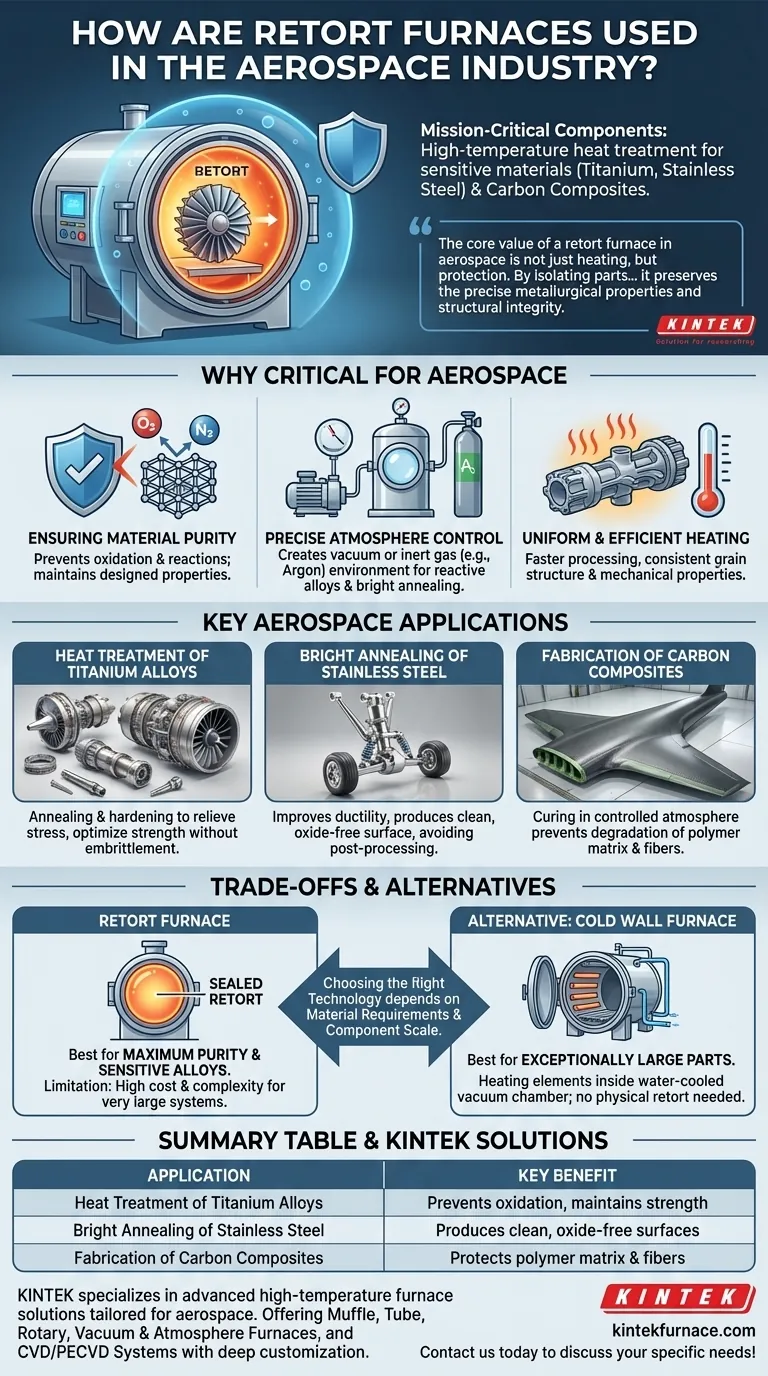In aerospace manufacturing, retort furnaces are used for the high-temperature heat treatment of mission-critical components, specifically those made from sensitive materials like titanium alloys and stainless steel, as well as for the fabrication of large-scale carbon composite assemblies. Their defining feature—a sealed inner chamber, or "retort"—creates a highly controlled atmosphere, which is essential for meeting the stringent quality and performance standards of the industry.
The core value of a retort furnace in aerospace is not just heating, but protection. By isolating parts from reactive atmospheric gases during high-temperature processing, it preserves the precise metallurgical properties and structural integrity required for components like landing gear and engine parts.
Why Retort Furnaces are Critical for Aerospace
The extreme operating conditions of aircraft and spacecraft demand materials with flawless integrity. Retort furnaces are a key tool for achieving this by providing an ideal processing environment.
Ensuring Material Purity
At elevated temperatures, metals like titanium can easily react with oxygen and nitrogen in the air. This reaction, called oxidation, compromises the material's strength and fatigue resistance.
A retort furnace's sealed chamber prevents these reactions, ensuring the material properties remain exactly as designed after heat treatment.
Providing Precise Atmosphere Control
The retort allows operators to create a vacuum or fill the chamber with a specific, non-reactive (inert) gas like argon.
This level of atmospheric control is non-negotiable for processing reactive alloys and is essential for processes like the "bright annealing" of stainless steel, which produces a clean, oxide-free surface finish.
Achieving Uniform and Efficient Heating
Retort furnaces are designed for efficient heat transfer, leading to faster processing times and more uniform temperature distribution across the part.
This uniformity is critical for achieving consistent grain structure and mechanical properties throughout a large or complex component, while the efficiency helps reduce energy consumption and operational costs.
Key Aerospace Applications
Retort furnaces are not used for all heat treatment, but they are specifically chosen for processes where material purity is paramount.
Heat Treatment of Titanium Alloys
Titanium parts, widely used in airframes, landing gear, and engine components, are a primary application.
Processes like annealing and hardening are performed in retort furnaces to relieve internal stresses and optimize strength without introducing the embrittlement that atmospheric contamination would cause.
Bright Annealing of Stainless Steel Parts
Many aerospace components made from stainless steel must be annealed to improve ductility and reduce hardness.
Using a retort furnace for this process ensures the parts emerge with a bright, clean surface, avoiding the need for costly and time-consuming post-processing steps like acid pickling to remove scale.
Fabrication of Carbon Composites
Large, macro-scale carbon composite assemblies also benefit from the controlled environment of a retort furnace.
During curing and other thermal fabrication steps, the controlled atmosphere prevents the degradation of the polymer matrix or carbon fibers, ensuring the final component meets its designed performance specifications.
Understanding the Trade-offs and Alternatives
While powerful, the retort furnace is not a universal solution. Understanding its limitations is key to making sound engineering decisions.
The Cost and Size Limitation
The defining feature—the sealed retort itself—adds significant cost and complexity to the furnace, especially for very large systems.
Fabricating, maintaining, and handling a massive metal retort can become impractical and prohibitively expensive as component sizes scale up.
The Alternative: Cold Wall Furnaces
For processing exceptionally large parts, such as massive airframe sections, a cold wall furnace is often the chosen alternative.
In these systems, the heating elements are located inside a vacuum chamber with water-cooled walls. This design avoids the need for a costly physical retort while still providing a controlled vacuum environment, though it has different heating characteristics and cost profiles.
Making the Right Choice for Your Process
Selecting the appropriate thermal processing technology depends entirely on the material requirements and the scale of the component.
- If your primary focus is achieving maximum material purity and preventing any atmospheric contamination: The sealed, controlled environment of a retort furnace is the definitive choice for sensitive alloys like titanium.
- If your primary focus is processing exceptionally large components where a physical retort is impractical: A cold wall furnace becomes the necessary alternative, providing a vacuum environment suitable for very large-scale parts.
Ultimately, choosing the right furnace is a critical decision in guaranteeing that aerospace materials perform flawlessly under extreme stress.
Summary Table:
| Application | Key Benefit |
|---|---|
| Heat Treatment of Titanium Alloys | Prevents oxidation, maintains strength and fatigue resistance |
| Bright Annealing of Stainless Steel | Produces clean, oxide-free surfaces, reduces post-processing |
| Fabrication of Carbon Composites | Protects polymer matrix and fibers during curing processes |
KINTEK specializes in advanced high-temperature furnace solutions tailored for aerospace needs. Leveraging exceptional R&D and in-house manufacturing, we offer Muffle, Tube, Rotary Furnaces, Vacuum & Atmosphere Furnaces, and CVD/PECVD Systems. With strong deep customization capabilities, we precisely meet unique experimental requirements for materials like titanium alloys and carbon composites. Enhance your lab's efficiency and ensure flawless component performance—contact us today to discuss your specific needs!
Visual Guide

Related Products
- 1400℃ Controlled Inert Nitrogen Atmosphere Furnace
- 1700℃ Controlled Inert Nitrogen Atmosphere Furnace
- Mesh Belt Controlled Atmosphere Furnace Inert Nitrogen Atmosphere Furnace
- 1200℃ Controlled Inert Nitrogen Atmosphere Furnace
- Vacuum Heat Treat Sintering Furnace with Pressure for Vacuum Sintering
People Also Ask
- How does a batch type controlled atmosphere furnace operate? Master Precision Heat Treatment for Superior Materials
- What is the main purpose of heat treatment? Transform Metal Properties for Superior Performance
- What industries commonly use inert atmosphere heat treating? Key Applications in Military, Automotive, and More
- Why are inert atmosphere furnaces important for graphite and carbon products? Prevent Oxidation and Ensure High-Performance Results
- What are the benefits of inert atmosphere heat treating? Prevent Oxidation and Preserve Material Integrity



















